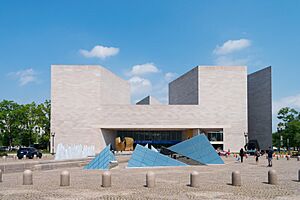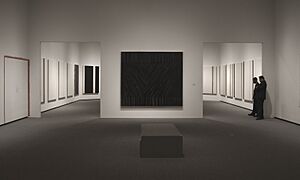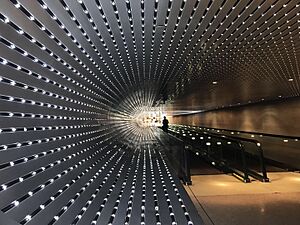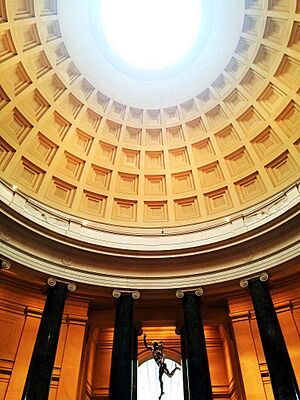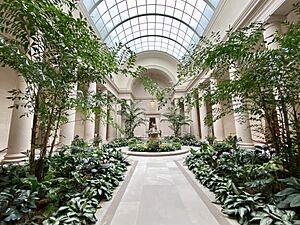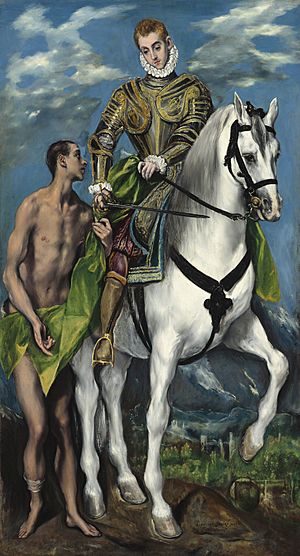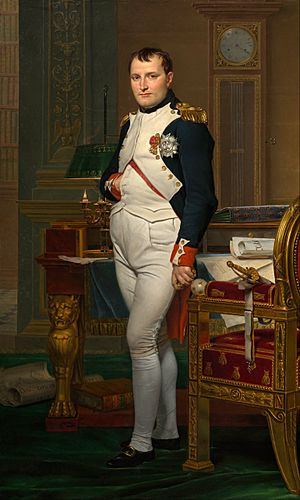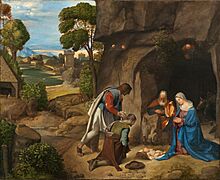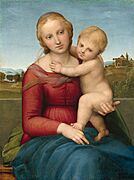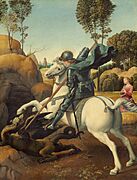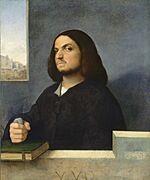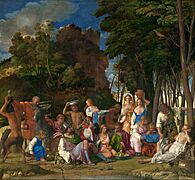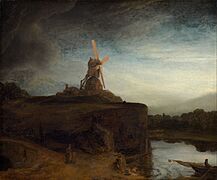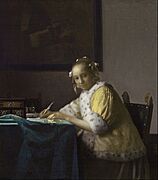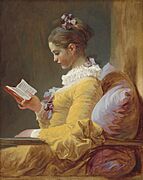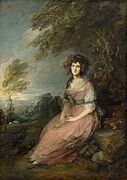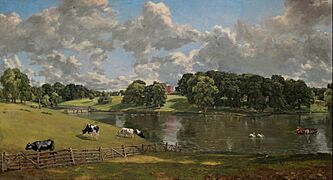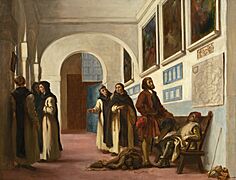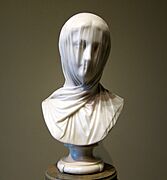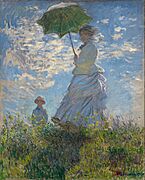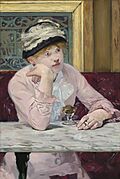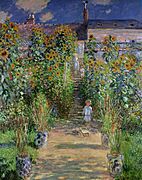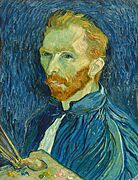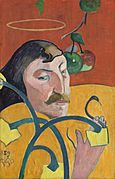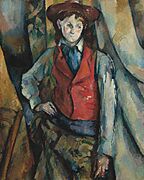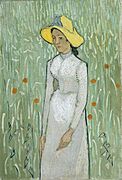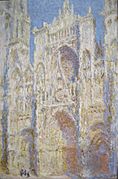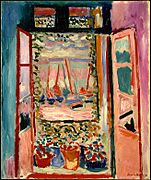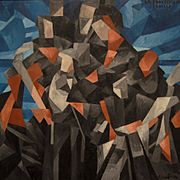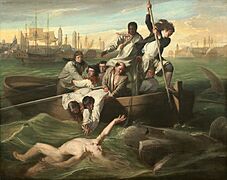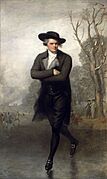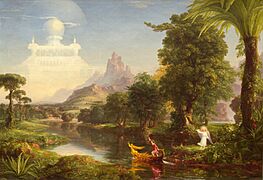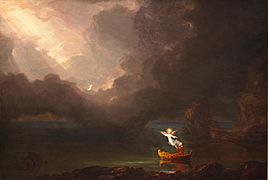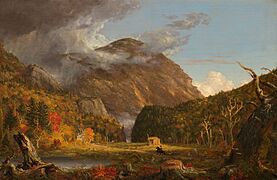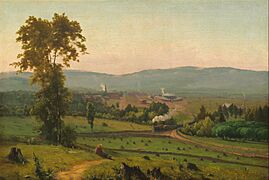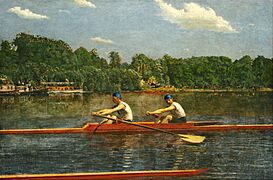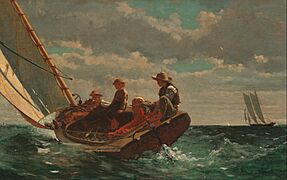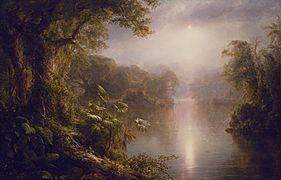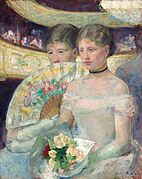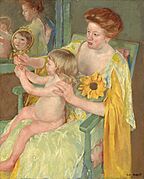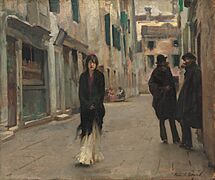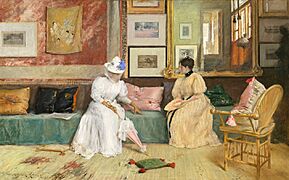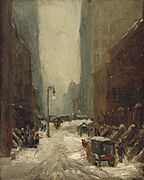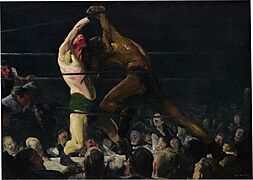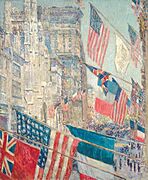National Gallery of Art facts for kids
 |
|
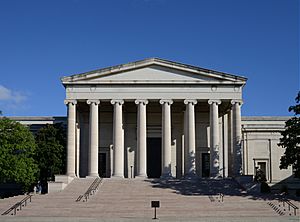
The West Building facade of the National Gallery of Art in Washington, D.C.
|
|
| Lua error in Module:Location_map at line 420: attempt to index field 'wikibase' (a nil value). | |
| Established | 1937 |
|---|---|
| Location | National Mall between 3rd and 9th Streets at Constitution Avenue N.W., Washington, D.C., U.S. |
| Collection size | 75,000 prints |
| Visitors | 3,936,543 (2024) – ranked second among U.S. art museums, seventh globally |
| Public transit access | Metrobus: 4th Street and 7th Street NW DC Circulator: 4th Street and Madison Drive; 9th Street and Constitution Avenue NW |
The National Gallery of Art is a famous art museum located in Washington, D.C., United States. You can find it on the National Mall, a large open area in the city. It's special because it's free to visit and was created for all Americans.
A man named Andrew W. Mellon started the museum in 1937. He gave a huge collection of art and money to build it. Many other generous people also donated their art over the years. The museum's collection includes paintings, drawings, sculptures, and more. It shows how Western art has changed from the Middle Ages to today. You can even see the only painting by Leonardo da Vinci in the Americas here!
The museum has two main buildings: the older West Building and the modern East Building. They are connected underground. There's also a beautiful Sculpture Garden outside. The National Gallery of Art is one of the biggest museums in North America. In 2024, nearly 4 million people visited, making it the second most-visited art museum in the U.S. It's the only top art museum in the country that doesn't charge an entry fee.
Contents
History of the National Gallery of Art
How the Museum Started
Andrew W. Mellon, a banker from Pittsburgh and a government official, began collecting old master paintings and sculptures during World War I. By the late 1920s, he decided he wanted to create a new national art gallery for the United States.
In 1930, Mellon bought 21 paintings from the Hermitage Museum in Russia. These included famous works like Raphael's Alba Madonna and Titian's Venus with a Mirror. He planned for these artworks to be part of his new gallery.
In January 1937, Mellon officially offered his art collection and money to build the new gallery. On March 24, 1937, the U.S. Congress accepted his amazing gift. They approved building the museum on the National Mall.
The new gallery was given the name "National Gallery of Art." Another gallery, which was part of the Smithsonian Institution, changed its name to the "National Collection of Fine Arts" (now called the Smithsonian American Art Museum).
Building the Museum and Its Growth
The land where the museum stands used to be a train station. In 1881, President James Garfield was shot there. The station was later taken down.
The West Building was designed by architect John Russell Pope. It was finished in 1941 and was the largest marble building in the world at the time. Sadly, neither Mellon nor Pope lived to see the museum completed.
Many other people were inspired by Mellon's gift and donated their own art collections. This helped the National Gallery grow even bigger.
Later, in the 1970s, Mellon's children, Paul Mellon and Ailsa Mellon Bruce, paid for the East Building. This modern building was designed by architect I. M. Pei and opened in 1978. It was built to hold the museum's collection of modern art, as well as research centers.
The last part added to the museum complex was the Sculpture Garden. It opened in 1999 and provides a beautiful outdoor space for large sculptures.
How the Museum Works
The National Gallery of Art is a partnership between the government and private donors. The U.S. government helps pay for the museum's daily operations and upkeep. All the artwork and special programs are paid for by private donations.
The museum has had several important directors over the years. Since March 2019, Kaywin Feldman has been the director. She was the director of the Minneapolis Institute of Art before coming here.
Visiting both buildings of the National Gallery of Art is completely free. The museum is open every day from 10 a.m. to 5 p.m., except on December 25 and January 1.
During the COVID-19 pandemic, the museum was mostly closed. But visitors could still make appointments to see parts of the West Building in small groups.
Learning and Research at CASVA
The Center for Advanced Study in the Visual Arts (CASVA) is the museum's research center. It was started in 1979. CASVA offers special programs for visiting professors, fellowships for researchers, and internships for college students. It also publishes books and studies about art.
Museum Architecture
The National Gallery of Art has two main buildings: the West Building (built in 1941) and the East Building (built in 1978). An underground passage connects them.
The West Building is made of pink Tennessee marble. It was designed in a neoclassical style, which means it looks like ancient Greek and Roman buildings. It has a large dome in the center, similar to the Pantheon in Rome. Inside, there are long halls with skylights and bright garden courts.
The West Building holds a huge collection of paintings and sculptures by European artists from the Middle Ages to the late 1800s. It also has American art from before the 20th century. Some famous artists whose works you can see here include Jan Vermeer, Rembrandt van Rijn, Claude Monet, Vincent van Gogh, and Leonardo da Vinci.
The East Building looks very different. It was designed by I. M. Pei in a modern, geometric style. It uses triangles in its design, which you can see everywhere in the building.
The most striking part of the East Building is its tall, open central area called the atrium. It's also made of the same Tennessee marble as the West Building.
In 2005, some of the marble panels on the East Building started to show wear. They were carefully removed and reinstalled to make sure they were safe. The renovation was finished in 2016.
The East Building focuses on modern and contemporary art. It has works by artists like Pablo Picasso, Henri Matisse, Jackson Pollock, Andy Warhol, and Alexander Calder. This building also has the main offices and a large research center.
The two buildings are connected by an underground walkway called "the Concourse." In 2008, artist Leo Villareal created an amazing light sculpture here called Multiverse. It uses about 41,000 computer-controlled LED lights to create a dazzling display. The Concourse also has a food court and a gift shop.
The Sculpture Garden is the final part of the museum complex. It's located west of the West Building. This 6.1-acre garden was designed as an outdoor gallery for large modern sculptures.
The Sculpture Garden has many native plants and trees. A circular reflecting pool and fountain are at its center. In winter, the pool becomes an ice-skating rink! You can see sculptures by artists like Marc Chagall, Roy Lichtenstein, and Joan Miró here.
Building Updates and Renovations
The West Building was updated between 2007 and 2009. Some parts closed for a while, but others stayed open.
The East Building also needed major renovations. In 2011, work began to fix the outside of the building. The pink marble panels on the walls were carefully removed and reinstalled with new, stronger anchors. This work was completed in 2014.
In 2013, the National Gallery announced a large renovation for the inside of the East Building. This included updating the building's systems and creating new exhibition spaces. Because of the work, most of the East Building closed in December 2013 and reopened three years later. Generous donors helped pay for this big project.
Art Collection Highlights
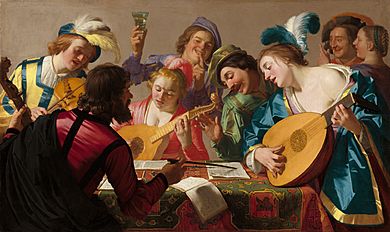
The National Gallery of Art's collection includes European and American paintings, sculptures, drawings, photographs, and decorative arts. The paintings cover art from the Middle Ages to today.
The Italian Renaissance collection has famous works like two panels from Duccio's Maesta, Giorgione's Allendale Nativity, and Giovanni Bellini's The Feast of the Gods. A very special piece is Ginevra de' Benci, the only painting by Leonardo da Vinci in the Americas! There are also many works by Titian and Raphael.
The museum also has paintings by other European masters, such as El Greco, Albrecht Dürer, Rembrandt, Johannes Vermeer, and Francisco Goya. The sculpture collection includes works by Auguste Rodin and Edgar Degas.
The National Gallery has a huge collection of 75,000 prints. These include works by Albrecht Dürer, Rembrandt, William Blake, and Mary Cassatt. This collection started with just 400 prints in 1941 and has grown thanks to many donors.
In 2013, the museum bought a painting called The Concert by Gerard van Honthorst. This 1623 painting had not been seen by the public since 1795! It is now on permanent display in the museum's Dutch and Flemish galleries.
Famous Artworks You Can See
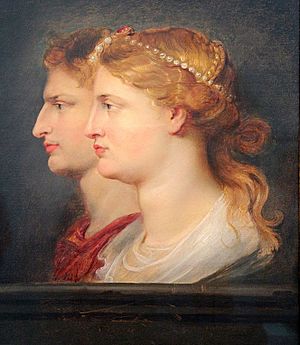
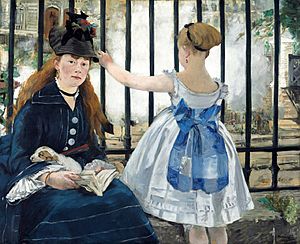
-
Giorgione, Adoration of the Shepherds, c. 1500
-
Raphael, Cowper Madonna, 1504–05
-
Raphael, Saint George and the Dragon, 1506
-
Giovanni Bellini and Titian, The Feast of the Gods, c. 1514
-
Nicolas Poussin, The Assumption of the Virgin, c. 1626
-
Rembrandt van Rijn, The Mill, 1648
-
Rembrandt van Rijn, Self Portrait with Beret and Turned-Up Collar, 1659
-
Johannes Vermeer, A Lady Writing a Letter, 1665–1666
-
Jean-Honoré Fragonard, A Young Girl Reading, c. 1776
-
Thomas Gainsborough, Mrs. Richard Brinsley Sheridan, 1787
-
Jean Auguste Dominique Ingres, Marcotte d'Argenteuil, 1810
-
John Constable, Wivenhoe Park, 1816
-
Eugène Delacroix, Columbus and His Son at La Rábida, 1838
-
Édouard Manet, The Old Musician, 1862
-
Claude Monet, Woman with a Parasol – Madame Monet and Her Son, 1875
-
Édouard Manet, The Plum, 1878
-
Claude Monet, The Artist's Garden at Vétheuil, 1880
-
Vincent van Gogh, Self-portrait, August 1889
-
Paul Gauguin, Self-Portrait with Halo and Snake, 1889
-
Paul Cézanne, Boy in a Red Waistcoat, 1888–1890
-
Vincent van Gogh, Girl in White, 1890
-
Claude Monet, Rouen Cathedral, West Facade, Sunlight, 1894
-
Henri Matisse, Open Window, Collioure, 1905
-
Pablo Picasso, Family of Saltimbanques, 1905
-
Henri Rousseau, The Equatorial Jungle, 1909
-
Francis Picabia, The Procession, Seville, 1912
-
Albert Gleizes, Les Joueurs de football (Football Players), 1912–13
-
Pablo Picasso, Still Life, 1918
Cool American Artworks
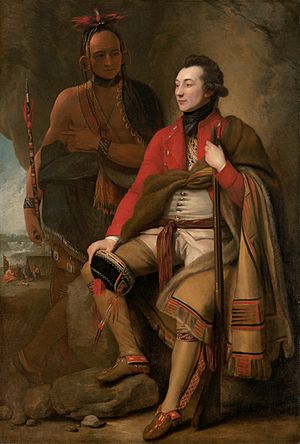

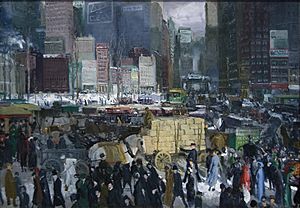
-
John Singleton Copley, Watson and the Shark, (original version), 1778
-
Gilbert Stuart, The Skater, 1782
-
Edward Hicks, Peaceable Kingdom, around 1834
-
Thomas Cole, The Voyage of Life: Childhood
-
Thomas Cole, The Voyage of Life: Youth
-
Thomas Cole, The Voyage of Life: Manhood
-
Thomas Cole, The Voyage of Life: Old Age
-
Thomas Cole, A View of the Mountain Pass Called the Notch of the White Mountains (Crawford Notch), 1839
-
George Inness, The Lackawanna Valley, 1855
-
Thomas Eakins, The Biglin Brothers Racing, 1873
-
Winslow Homer, Breezing Up (A Fair Wind), 1873–1876
-
Frederic Edwin Church, Morning in The Tropics, (1877)
-
Mary Cassatt, The Loge, 1882
-
Mary Cassatt, Woman with a Sunflower, 1905
-
John Singer Sargent, Street in Venice, 1889
-
William Merritt Chase, A Friendly Call, 1895
-
Robert Henri, Snow in New York, 1902
Images for kids
-
North face of the West Building, with the west side of the East Building and the United States Capitol in background
See also
 In Spanish: Galería Nacional de Arte para niños
In Spanish: Galería Nacional de Arte para niños
- Collections of the National Gallery of Art
- List of national galleries
- List of original Hermitage paintings in the National Gallery of Art
- Architecture of Washington, D.C.
- List of largest art museums
- List of most-visited museums in the United States


